Indiana Graduates and Brain Drain
The Clash’s hit song "Should I Stay or Should I Go?" states the dilemma well. Should a graduate of an Indiana institution of higher learning stay in the state to work and put down roots or go elsewhere to seek his or her possible fortunes?
Just how many graduates of Indiana public colleges stay or go? In what proportions? Graduates are not a homogeneous group. A graduate’s major may have an influence on their decision is to stay in the state or not. The following analysis uses a relatively new database that can show how many graduates from a public college in the state remain to work in Indiana or not. (Data for private institutions are not currently available.)
The data are from the Indiana Workforce Intelligence System (IWIS). By aggregating student-record level data, we can determine how many recent bachelor’s degree graduates from Indiana's public institutions remained to work in the years after graduation. The sample included 156,587 bachelor’s degree recipients who graduated between 2002 and 2011.
The research team created three groups based on how long ago a person graduated. Group 1 consisted of graduates one year after graduation. Groups 3 and 5 correspond to graduates three and five years after graduation, respectively.
Brain Drain Increases over Time
Figure 1 shows that the tendency of bachelor’s degree graduates to stay and work in Indiana after graduation declines over time. The probability of Indiana employment was highest one year after graduation (66 percent), with the remain-rate falling to 59 percent after three years and 55 percent after five years. Despite this downward trend, more than half of Indiana’s public institution bachelor’s degree recipients were still employed in the state five years after graduation.
Figure 1: Probability of Working in Indiana after Graduation by Group
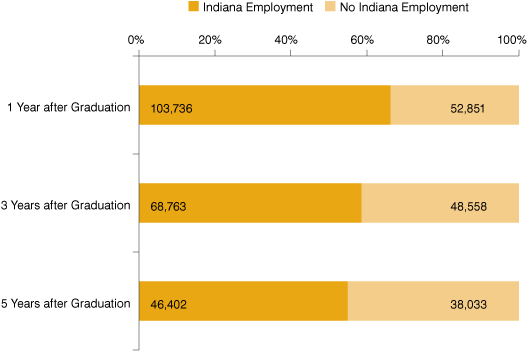
Source: IBRC, using IWIS data
As Figure 2 shows, the remain-rates for Indiana residents were more than twice as high as for those who were non-residents at the time of attending college. The relatively small group of graduates with unknown residency status had higher remain-rates (by 4 percent or more) than Indiana residents in each group, suggesting that many of those with unknown residency status were likely Indiana residents.
Figure 2: Remain-Rates by Residency Status
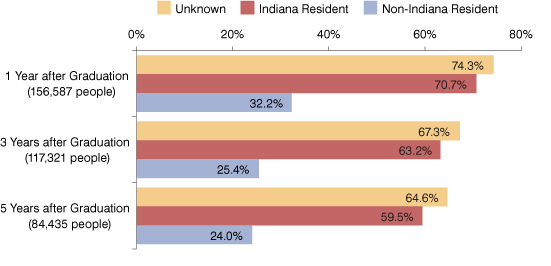
Source: IBRC, using IWIS data
Differences by Academic Major
Of the 41 possible academic majors (based on two-digit CIP codes),1 Group 1 contained graduates in 32. However, nearly three out of four graduates, regardless of the group, graduated in one of 10 majors: business, education, health, communication and journalism, liberal arts and sciences, social sciences, visual and performing arts, engineering technologies, psychology, and engineering.
Table 1 shows the “top 10” concentrations of graduates per academic major for each group. Five of those most popular majors (health, education, liberal arts and sciences, engineering technologies, and business) were also in the top 10 in terms of remain-rates.
Table 1: Graduate Distribution by Academic Major and Group
| Group 1 | Group 3 | Group 5 | ||||
|---|---|---|---|---|---|---|
| Academic Major* | Number of Graduates | Percent | Number of Graduates | Percent | Number of Graduates | Percent |
| Business | 28,552 | 18.2 | 22,126 | 18.9 | 16,251 | 19.3 |
| Education | 17,700 | 11.3 | 13,474 | 11.5 | 9,559 | 11.3 |
| Health | 12,925 | 8.3 | 8,917 | 7.6 | 5,854 | 6.9 |
| Communication and Journalism | 11,996 | 7.7 | 9,269 | 7.9 | 6,881 | 8.2 |
| Liberal Arts and Sciences | 9,996 | 6.4 | 7,348 | 6.3 | 5,244 | 6.2 |
| Social Sciences | 8,135 | 5.2 | 5,956 | 5.1 | 4,182 | 5.0 |
| Visual and Performing Arts | 6,752 | 4.3 | 5,052 | 4.3 | 3,641 | 4.3 |
| Engineering Technologies | 6,552 | 4.2 | 5,037 | 4.3 | 3,629 | 4.3 |
| Psychology | 6,219 | 4.0 | 4,656 | 4.0 | 3,396 | 4.0 |
| Engineering | 6,013 | 3.8 | 4,410 | 3.8 | 3,218 | 3.8 |
| Subtotal | 114,840 | 73.3 | 86,245 | 73.5 | 61,855 | 73.3 |
| Total | 156,587 | 100 | 117,321 | 100 | 84,435 | 100 |
*Majors shown in bold also had one of the 10 highest remain-rates.
Source: Integrated Postsecondary Education Data System (IPEDS)
Overall, graduates with a legal professions degree had the highest remain-rates (over 70 percent) in each group.
The majors with the lowest remain-rates were also consistent across groups. Graduates with degrees in transportation, philosophy or engineering, for example, were among the least likely to stay and work in Indiana.
The following figures illustrate the effect of program of study on graduates staying and working in the state.
One year out, graduates in 28 different majors had over a 50 percent chance (above the dashed line) of still working in Indiana. Engineering and communications technology graduates were the only ones fresh out of college who more likely not to be working in the state (see Figure 3).
Figure 3: Probability of Working in Indiana One Year after Graduation by Major (Group 1)
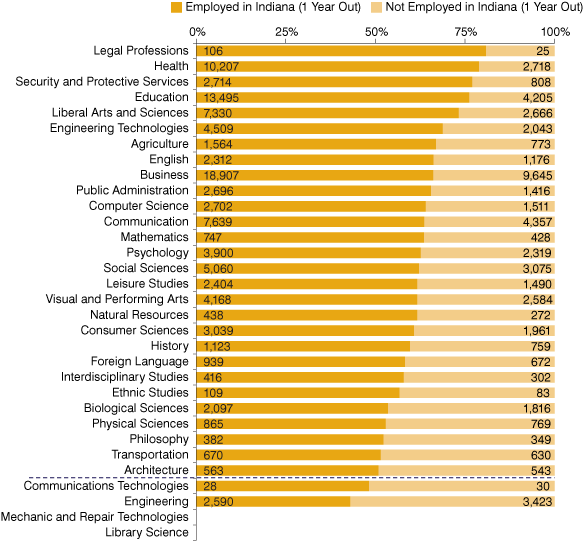
Note: Majors with no data have either too few, or no, observations to display.
Source: IBRC, using IWIS data
Three years out (Group 3), average remain-rates below 50 percent now applied to graduates in 10 majors instead of just two (see below the dashed line of Figure 4). In addition to communication technology and engineering, graduates in foreign languages, ethnic studies, interdisciplinary studies, architecture, physical sciences, transportation, biology and philosophy were also more likely now to be employed outside of Indiana.
Figure 4: Probability of Working in Indiana Three Years after Graduation by Major (Group 3)
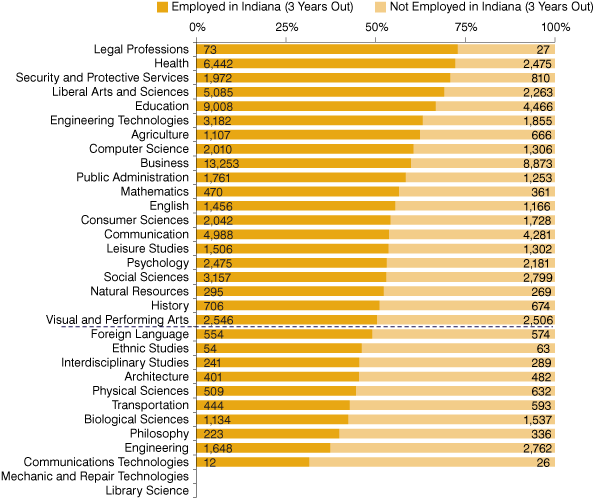
Note: Majors with no data have either too few, or no, observations to display.
Source: IBRC, using IWIS data
Five years out (Group 5), the number of different majors where graduates were more likely to be working in state than out of state fell to 14 (see Figure 5 above the dashed line)—a 50 percent reduction compared to Group 1.
Figure 5: Probability of Working in Indiana Five Years after Graduation by Major (Group 5)
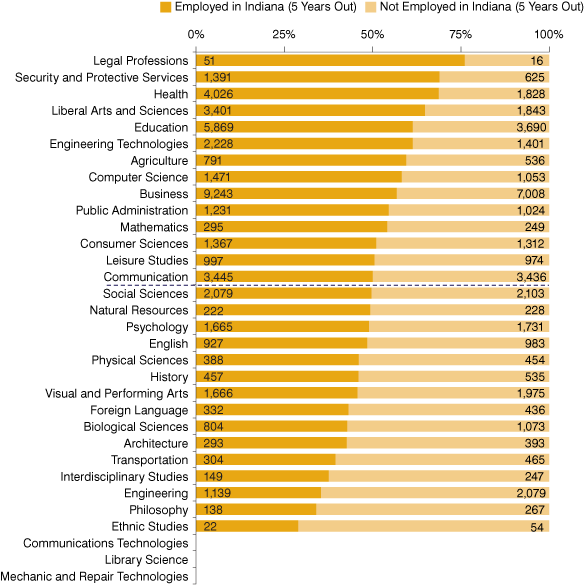
Note: Majors with no data have either too few, or no, observations to display.
Source: IBRC, using IWIS data
The majors of graduates with remain-rates greater than 50 percent included legal professions, security and protective services, health, liberal arts and sciences, education, engineering technologies, agriculture, computer and information sciences, business, public administration, mathematics, family and consumer sciences, leisure studies, and communication.
Conclusion
One year after graduation, 66 percent of graduates from public institutions remained and were working in the state. Over time, however, the remain-rate falls to 59 percent after three years and, after five years, 55 percent of graduates were working in the state. Does this imply that Indiana suffers from a brain drain?
Or does it imply that Indiana suffers from an opportunity deficit? These are huge questions that can’t really be addressed in a short, descriptive article informed by secondary data. Secondary data can’t answer the why questions, but one may speculate that the reason Indiana engineering graduates have a relatively low remain-rate is a lack of employment opportunities at competitive compensation in the state.
The low remain-rates for engineering may impinge on Indiana’s ability to compete, innovate and sustain leadership in high-tech manufacturing. Policy makers may also begin asking the why questions as to whether and why other STEM-related disciplines move away at above-average rates over time.
Majors with generally higher remain-rates tend to be graduates that find employment that is driven by population, for example, health care, education, and security and protective services. (It would be interesting to see how many of the business majors stay in the state and work in retail.) Other majors—English or history, for example—may move away over time at greater than average rates as they transition from just-out-of-college-stop-gap employment in the state to more permanent career opportunities out of state.
This analysis presented the nuances associated with the question of brain drain in Indiana. Remain-rates depend on a graduate’s major and the length of time since graduation. Over time, the IWIS database will also be able to answer the question about whether those graduates that left the state soon after graduation returned. Let us hope that answer is yes. The state could use the human capital.
Background Information about the Groups
While Group 1 included all graduates between 2002 and 2011, the joint constraints imposed by the most recent employment data (2012) and larger post-graduation time horizons restricted the number of graduates available for the last two Groups: Group 3 had to be restricted to graduates between 2002 and 2009; similarly, Group 5 included graduates between 2002 and 2007.
Group 1 had 156,587 graduates. More than 86 percent (135,350) of the graduates were Indiana residents, compared to 11.7 percent (18,273) non-residents (see Table 2).
Table 2: Indiana Residency Status by Group
| Indiana Residency | Group 1 | Group 3 | Group 5 |
|---|---|---|---|
| Indiana Resident | 135,350 | 99,790 | 70,357 |
| Non-Indiana Resident | 18,273 | 14,604 | 11,211 |
| Unknown | 2,964 | 2,927 | 2,867 |
| Total | 156,587 | 117,321 | 84,435 |
Source: IBRC, using IWIS data
Nearly 76 percent of the graduates in Group 1 attended either Indiana University (68,141; 43.5 percent) or Purdue University (50,740; 32.4 percent). These figures include each institution's main and regional campuses. The remaining institutional distribution of graduates was Ball State University (20,217: 12.9 percent); Indiana State University (9,400: 6 percent); University of Southern Indiana (7,872: 5 percent) and Vincennes University (217: 0.1 percent).
Group 3 contained 117,321 graduates and shared similar attributes with Group 1. For example, more than 85 percent (99,790) of the graduates were Indiana residents. The relative concentration of graduates from each institution also mirrored Group 1, with Indiana University having the largest (50,349; 42.9 percent) and Vincennes University (92; 0.1 percent) having the smallest.
Group 5 included 84,435 students who graduated between 2002 and 2007. The percentage of Indiana residents (83.3 percent) and non-residents (13.3 percent) decreased slightly, compared to the first two Groups. Group 5 graduates also predominantly attended Indiana (36,108: 42.8 percent) and Purdue (27,543: 32.6 percent) universities. The relative distribution of the remaining graduates was similar to Groups 1 and 3.
Notes
- For more information on the Classification of Instructional Program (CIP) structure, please visit the NCES website at http://nces.ed.gov/ipeds/cipcode/browse.aspx?y=55.
